ASLA: Kongjian Yu Wins 2023 Cornelia Hahn Oberlander International Landscape Architecture Prize
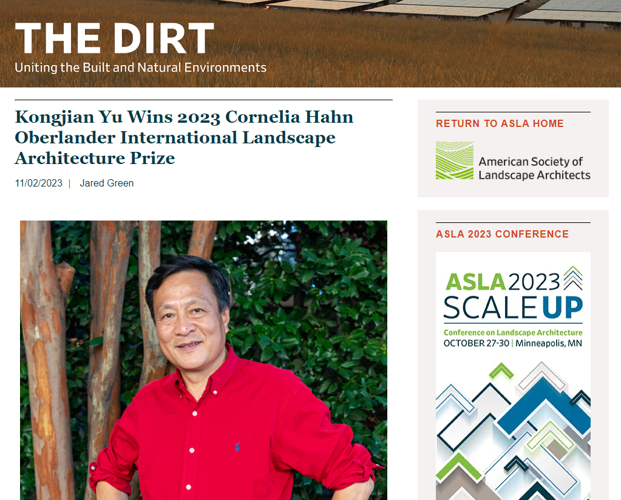
The Cultural Landscape Foundation (TCLF) announced Chinese landscape architect Kongjian Yu, FASLA, has won the 2023 Cornelia Hahn Oberlander International Landscape Architecture Prize for his influential planning, design, and advocacy work to advance “sponge cities.”
The biennial award of $100,000 will include two years of public engagement focused on Yu’s work, ideas, and the state of contemporary landscape architecture.
The prize is named after German-born Canadian landscape architect Cornelia Hahn Oberlander, FASLA, who passed away in 2021 at age 99.
TCLF states that the prize is bestowed on a recipient who is “exceptionally talented, creative, courageous, and visionary” and has “a significant body of built work that exemplifies the art of landscape architecture.”
The seven-person international prize jury, chaired by Elizabeth Mossop, FASLA, wrote: “A brilliant and prolific designer, Kongjian Yu is also a force for progressive change in landscape architecture around the world. Through built works, lectures, publications, teaching, and a series of celebrated letter to the leaders of China, he has striven to direct landscape practices away from a destructive confrontation with natural forces toward a more optimistic position of cooperation and adaptation.”
Yu said: “I deeply appreciate the jury for their brave decision to recognize my work, when there were so many talented nominees who I believe much deserve this prize. They include our fields’ well-established giants in developed countries, who have inspired my work.”
“I deeply believe that landscape architecture can and will play a key role in healing the planet. As Cornelia Oberlander stated: ‘Landscape architects must be leaders, especially in dealing with the effects of climate change.’”
Yu’s “sponge cities” concept is about using nature-based solutions to reduce widespread urban flooding brought on by development and climate change. These solutions act as “sponges soaking up rainfall” instead of containing and conveying water through traditional concrete infrastructure.
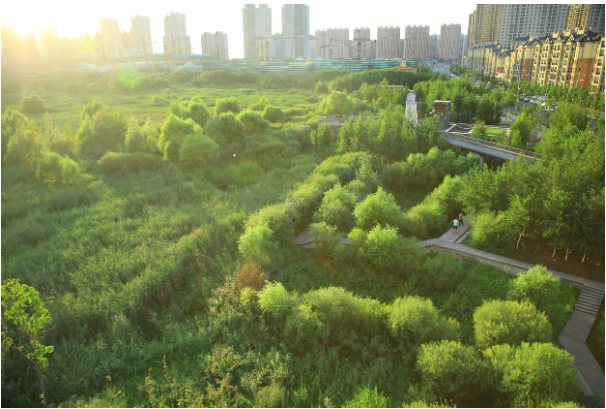
ASLA 2012 Professional General Design Award of Excellence. A Green Sponge for a Water-Resilient City: Qunli Stormwater Park. Haerbin City, Heilongjiang Province, China / © Turenscape
Sponges can be layered and take a variety of forms: “constructed wetlands, greenways, parks, canopy tree and woodland protection, rain gardens, green roofs, permeable pavements, bioswales, and other measures.”
Thanks to Yu’s multi-decade advocacy campaign, China made investment in sponge cities its national policy in 2013.
Since then, more than 70 Chinese cities have implemented sponge policies and programs. The goal is that by 2030, 80% of the cities will absorb 70% of rainfall. This effort forms one of the planet’s most ambitious Mega Eco-Projects.
Charles Birnbaum, FASLA, President and CEO of TCLF, said Yu’s ideas are “inspiring planners and decision makers in Australia, Bangladesh, Canada, Denmark, Egypt, England, India, Indonesia, Kenya, Mexico, The Netherlands, New Zealand, Russia, Singapore, South Africa, Sweden, and elsewhere.”
Yu is the founder and leader of the Graduate School of Landscape Architecture and the College of Architecture and Landscape Architecture at Peking University in Bejing. He is also founder and principal designer of Turenscape, a landscape architecture firm with more than 400 employees.
According to TCLF, Yu and his firm have built 600 projects in more than 200 cities; mostly in China, but also in France, Indonesia, Russia, Singapore, Thailand, and the U.S.
A few of Yu’s key projects:
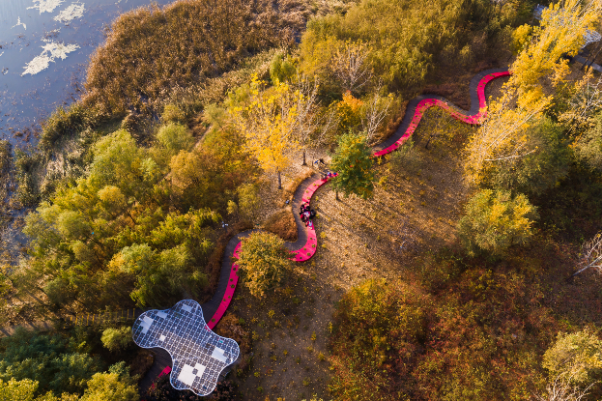
ASLA 2007 Professional General Design Honor Award. The Red Ribbon – Tanghe River Park, Qinhuangdao City, Hebei Province, China. Turenscape (Beijing Turen Design Institute) and Peking University Graduate School of Landscape Architecture, Beijing, China / © Turenscape
Red Ribbon Park
Qinhuangdao, Hebei Province, 2007
Once a make-shift garbage dump, Yu revitalized this landscape along the Tanghe River, weaving in diverse native plants and adding a “sinuous 1,640-feet-long (500-meter) red benchlike structure” that glows at night.
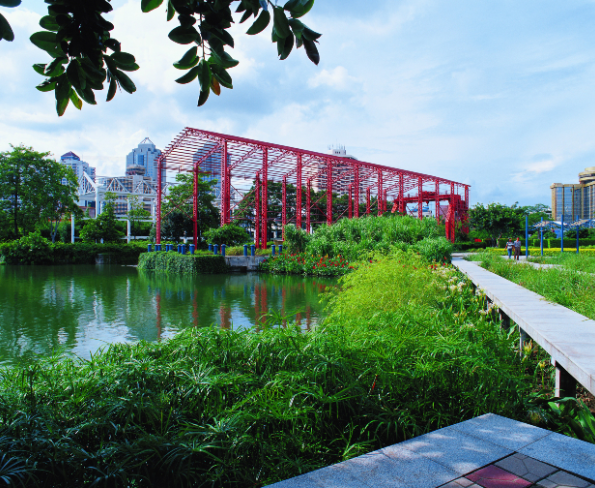
Zhongshan Shipyard Park, Zhongshan, Guandong Province, China, 2011 / © Turenscape courtesy The Cultural Landscape Foundation
Zhongshan Shipyard Park
Zhongshan, Guandong Province, 2001
Yu transformed a bankrupt shipyard built in the 1950s into a 27-acre park that retains and repurposes machines, docks, and other industrial structures. “Yu believes in the retention of cultural landscape heritage, including industrial sites and working landscapes,” TCLF writes.
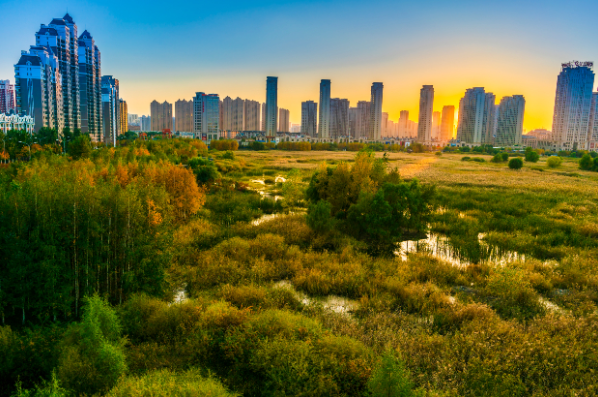
ASLA 2012 Professional General Design Award of Excellence. A Green Sponge for a Water-Resilient City: Qunli Stormwater Park. Haerbin City, Heilongjiang Province, China / © Turenscape
Qunli Stormwater Park
Qunli New District, Harbin City, Heilongjiang Province, 2011
“One of the first ‘sponge cities’ projects to gain wide attention, this 80-acre (34.2-hectare) national urban wetland park was created from a dying wetland.” Yu built ponds and mounds, with native grasses, meadows, and silver birch trees accessible via pathways and elevated walkways.
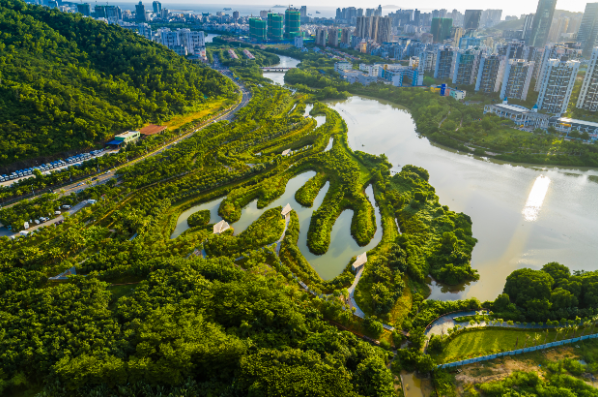
ASLA 2020 Professional General Design Honor Award. Deep Form of Designed Nature: Sanya Mangrove Park. Sanya City, Hainan Province, China. / © Turenscape
Sanya Mangrove Park
Sanya, Hainan Province, 2016
A landfill lined with concrete flood walls became a 24.7 (10 hectare) “lush and biodiverse” mangrove park along the Sanya River. “Finger-like landforms with skywalks connect with pathways that lead to elevated pavilions.”
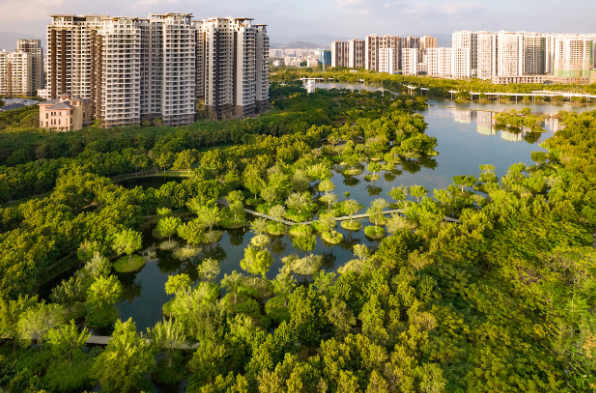
Sanya Dong’an Wetland Park, Sanya, Hainan Province, China, 2021 / ©Turenscape, courtesy The Cultural Landscape Foundation
Sanya Dong’an Wetland Park
Sanya, Hainan Province, 2016
“One of the earliest and the most significant demonstration and multi-functional projects of the nationwide sponge city effort.” 168 acres (68 hectares) of polluted wetlands were restored and became a park that also integrates ponds, rice paddies, greenways, and coastal habitat into a “holistic sponge system.”
And in the U.S., Yu designed:
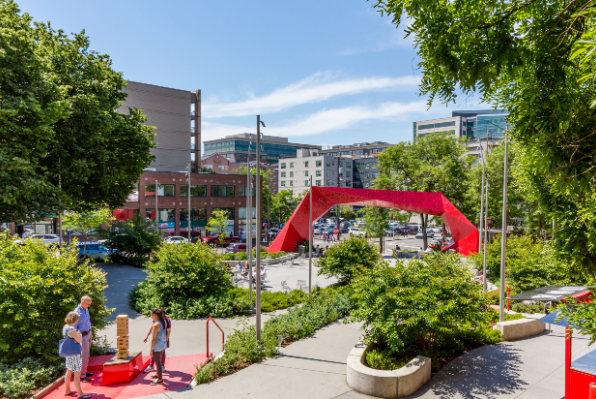
Hing Hay Park, Seattle, WA, 2018 / ©Miranda Estes, courtesy Turenscape and The Cultural Landscape Foundation
Hing Hay Park
Seattle, Washington, 2018
At two-thirds of an acre (.27-hectare), this small park in the Chinatown-International District Neighborhood features a bold red “metal gateway inspired by Asian paper cutting and folding traditions.” Yu partnered with the Seattle-based firm MIG | SvR to design a park with “multiple garden terraces, inspired by the rice paddies of Yu’s agrarian upbringing, and numerous gathering and performance spaces,” TCLF writes.
In the book Designed Ecologies: The Landscape Architecture of Kongjian Yu, (2012), William Saunders writes: “During the 1966 to 1976 Cultural Revolution … [Yu] grew up near an enchanting forest and a fish-filled creek, only to see the forest cut down and the creek become too polluted to support life. This helps explain the depth of his commitment to recreating and protecting natural abundance.”
“He suffered social ostracism in the countryside for having wealthy ancestors and then for being a ‘country bumpkin’ when he made it to the big city. This helps us understand his conviction that parks are to be enjoyed by all ranks of people.”
“He loved farming and was proud that his commune used every square meter of its land productively. This helps explain his revulsion to landscapes that are ‘merely’ ornamental.”
“He learned how to deploy scarce water resources and cultivate crops in ways that ensured their survival. And this helps us understand his will to create parks that are low-maintenance and ‘productive.’”
